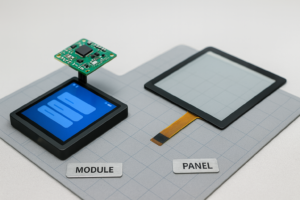Interactive touch screens are changing how retail stores and schools operate. These displays combine user-friendly controls with instant responses, making tasks faster and more engaging. In retail, interactive touch screen systems simplify checkout processes, reduce wait times, and help customers find products. In schools, they make learning more hands-on, letting students interact with lessons directly.
Demand is growing for POS terminal touch screens that handle payments smoothly, as well as embedded touch screen solutions built into counters or desks. Businesses want efficiency, while educators look for better ways to teach. Whether it’s a self-service kiosk or a digital whiteboard, touch screens bridge convenience and innovation.
This technology solves two key problems: slow retail transactions and passive learning. The right touchscreen system can speed up sales and make education more dynamic.
The Benefits of Interactive Touch Screen Displays
Interactive touch screen technology is transforming how businesses operate, offering tangible advantages in retail and beyond. These systems improve customer interactions while optimising backend operations. Below are two key areas where they make a significant impact.
Enhanced Customer Engagement in Retail
Interactive touch screen displays directly improve how customers interact with brands. Studies show stores using these systems see a 30% increase in dwell time and a 20% boost in conversions. The technology encourages exploration through features like virtual try-ons for clothing and cosmetics. Customers can preview products without physical samples, reducing friction in decision-making.
Self-service kiosks with interactive touch screen interfaces also reduce wait times. Restaurants and retail stores report higher order accuracy when customers input their requests. These screens often include upsell prompts, increasing average transaction values. The more intuitive the interface, the longer customers stay engaged.
Streamlined POS Terminal Operations
POS terminal touch screen systems simplify transactions for staff and customers. Cashiers process orders faster with clear, responsive interfaces. Training time drops by up to 50% because the systems are easier to learn than traditional button-based terminals.
A major electronics retailer implemented embedded touch screen panels directly into checkout counters. This saved space while allowing staff to manage inventory in real time. The system automatically flagged low-stock items, reducing the need for manual checks. Employees could also pull up product details instantly, improving customer service.
Future Trends in Touch Screen Technology
The next generation of interactive touch screen systems is bringing revolutionary changes to both the retail and education sectors. These advancements go beyond simple touch interfaces, introducing smarter, more immersive ways to interact with technology. Let’s examine two key developments shaping the future.
Augmented Reality (AR) for Retail & Education
Interactive touch screen displays are now merging with AR technology to create transformative experiences. In retail stores, AR mirrors allow customers to virtually try on clothing, accessories, or makeup without physical samples. Major fashion brands report a 40% increase in conversion rates when using these virtual fitting rooms.
Education is seeing similar innovations through AR-enabled interactive touch screen displays in science labs. Students can manipulate 3D models of molecules or historical artifacts, turning abstract concepts into tangible learning experiences. Schools implementing this technology note significant improvements in student engagement and information retention.
AI-Driven Personalization
Modern interactive touch screen systems now incorporate artificial intelligence to deliver customised experiences. Retail displays analyse customer demographics and browsing patterns to suggest relevant products in real-time. Stores using these intelligent recommendations see an average increase in order values of 15-20%.
In educational settings, AI-powered interactive touch screen displays adapt to individual learning styles. The systems track student progress and automatically adjust difficulty levels or suggest supplemental materials. This personalised approach has been shown to improve test scores by an average of 12% in pilot programs.
These advancements demonstrate how interactive touch screen technology is evolving from passive displays to intelligent, responsive systems. The integration of AR and AI represents just the beginning of this transformation, with more innovations on the horizon.
Interactive Touch Screens in Education
While commonly associated with retail, touch screen technology is making significant strides in education. These interactive systems are creating more engaging, effective learning environments while preparing students for real-world applications.
Digital Classrooms with Modern Touch Displays
Today’s classrooms increasingly incorporate large-format touch screens that serve as interactive whiteboards. These displays allow multiple students to collaborate simultaneously, solving problems or annotating lesson materials together. Teachers report that lessons using these tools see 25% higher participation rates compared to traditional methods.
Specialised educational software transforms these screens into dynamic learning stations. Science classes can manipulate 3d models of human anatomy, while history lessons can explore interactive timelines. The technology proves particularly valuable for visual and kinesthetic learners who benefit from hands-on interaction.
Preparing Students for Retail Careers
Vocational programs are adopting retail-focused applications of this technology. Many schools now use POS simulators with touch screens to train students for careers in the service industry. These realistic simulations teach skills in inventory management, transaction processing, and customer service.
Some forward-thinking institutions have created hybrid retail spaces where business students operate actual stores using professional-grade touch screen systems. This hands-on experience gives graduates practical skills that make them job-ready immediately after completion.
The transition from the classroom to the workplace becomes seamless when students train on the same technology they will use professionally. As educational institutions continue embracing these tools, we’re seeing a new generation of tech-savvy professionals entering both the retail and education fields.
Choosing the Right Touch Screen Solution
Selecting the optimal touch screen system requires careful evaluation of both hardware capabilities and software integration. The right choice depends on your specific operational needs and environment.
Essential Technical Specifications
When comparing systems, start by considering touch sensitivity. Multi-touch screens that recognize multiple simultaneous inputs enable collaborative work in classrooms or efficient order processing in retail. In contrast, single-touch models may suffice for basic kiosk applications.
Durability represents another critical factor. Screens for high-traffic retail environments need reinforced glass and waterproof designs, while classroom displays should withstand frequent student interaction. Look for models with at least IP54 certification for dust and moisture resistance.
Seamless System Integration
For retail applications, ensure new touch screens integrate flawlessly with existing POS terminal software. The best solutions offer plug-and-play compatibility with major retail management systems, requiring minimal IT support for installation.
Educational institutions should verify compatibility with learning management systems and educational software. Some displays now include built-in device mirroring, allowing teachers to share content from tablets or laptops directly to the main screen.
Consider future expansion capabilities. Modular systems allow for gradual upgrades, while all-in-one solutions may offer simpler maintenance. The ideal choice strikes a balance between current needs and room for technological evolution.
Implementation Considerations:
- Test displays under real-world conditions before purchase
- Factor in maintenance requirements and warranty coverage
- Consider the total cost of ownership, not just the initial price
- Evaluate vendor support for software updates and troubleshooting
The most effective solutions combine robust hardware with flexible software integration, ensuring long-term value regardless of application.
Conclusion: Transforming Industries with Interactive Touch Screens
Interactive touch screen technology has fundamentally changed how businesses and educational institutions operate. From retail POS systems that streamline transactions to dynamic classroom displays that enhance learning, these solutions bridge the gap between efficiency and engagement. The integration of advanced features, such as AR visualisation and AI-driven personalisation, continues to push boundaries across sectors.
About Ever Glory: Your Trusted Touch Screen Partner
At Ever Glory, we specialise in high-performance touch screen solutions for diverse applications. Our products stand out through:
- Flexible customisation with MOQS as low as 50 units
- 3-year warranty and rigorous quality control (0% lot rejection rate)
- Industrial-grade durability for medical, marine, and outdoor use
- Expert engineering support for seamless system integration
With 14+ years of experience and a 99% customer satisfaction rate, we help businesses and educators implement reliable touch technology.
Ready to upgrade?
Explore our POS terminal touch screens or educational displays today. Contact our team at +86-15818600974 or admin@ydtouch.com for tailored solutions.
.png)



